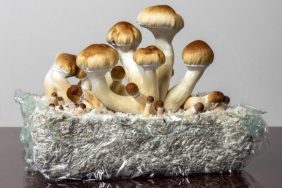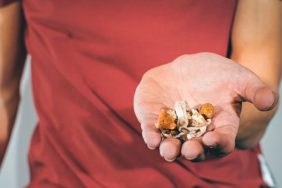Photo: © Alfonso Benayas, courtesy of Wikimedia Commons.
From tumeric, maca, and coconut to chia seeds, beets, and acai, superfoods make up some of the hottest trends on the market, as people search for natural, holistic ways to prevent and cure illness. Invariably, it’s never about one item but rather creating a diverse and balanced diet that brings together a wide array of healthy foods that work in synergy with each other, and which your body enjoys.
Also: Veggies Gone Wild: New Study Says Eat 10 Servings of Fruits & Veg a Day for a Longer Life
If you’re looking for something new and fresh to throw into the mix, look no further than medicinal mushrooms. Mushrooms are so unique that they have their own kingdom: fungi. Neither plant now animal, they are something else, having diverged from plant life more than one billion years ago. During that time, several of them have evolved into powerhouses of nutritional benefits. Crave spotlights five medicinal mushrooms for you to check out, redefining the joys of shrooming in the new millennium.

Lion’s Mane Mushrooms. Photo © Rob Hille, courtesy of Wikimedia Commons.
Lion’s Mane
The Lion’s Mane mushroom is a particularly attractive fungi, with its lush tendrils that are as delicate to the touch as they are visually unique. It goes by a wide array of names including Hedgehog, Satyr’s Beard, and Pom-Pom, revealing how closely it speaks to the human imagination.
Long used in traditional Chinese medicine, a 2013 study in the Journal of Complementary and Integrative Medicine of the fungus determined, “This mushroom is rich in some physiologically important components, especially β-glucan polysaccharides, which are responsible for anti-cancer, immuno-modulating, hypolipidemic, antioxidant and neuro-protective activities of this mushroom.” The study further concluded that Lion’s Mane has anti-microbial, anti-hypertensive, anti-diabetic, and wound healing properties—providing a panoply of healing properties and applications.

Shiitake Mushrooms. Photo: © Frankenstoen, courtesy of Wikimedia Commons.
Shiitake
Shiitakes are one of the most popular mushrooms on earth, a staple in the Asian diet for centuries. Packed with B vitamins, they are known to reduce inflammation, control blood sugar levels, fight inflammation, cancer cells, and cardiovascular disease.
A 2015 study in the Journal of the American College of Nutrition revealed that daily consumption of Shiitake mushrooms resulted in improved immunity, as it helped to improve gut health and reduce inflammation. A 2006 study published by the National Institutes of Health concluded that Shiitake mushrooms could destroy cancer cells and inhibit tumor growth.

Chaga Mushrooms. Photo © Tad Montgomery. Courtesy of Wikimedia Commons.
Chaga
For centuries, the people of the North inhabiting sections of Europe, Asia, Russia, and Siberia have picked Chaga mushrooms off the side of birch trees, ground them up, and added them to soups and teams to boost physical stamina and improve their quality of life. People in these harsh climates easily lived to ripe old age, some of them going for as long as 110 years.
Chaga is considred the king of medicinal mushrooms, used in different groups to treat various illnesses like cancer, tumors, skin inflammations, bronchitis, and stress.

Reishi mushroom. Photo © Dave O, courtesy of Wikimedia Commons.
Reishi
Popular in Japan and China, Reishi mushrooms have long been enjoyed for their health benefits. The vibrant reddish brown mushroom is usually ground up and added to hot beverages like teas and soups, or taken in capsule form.
Powered by polysaccharides and triterphenes, Reishi mushrooms are believed to have antioxidant properties that support and stimulate the immune system, helping to fight against various long-term degenerative diseases. According to Memorial Sloan Kettering Cancer Center, “Reishi mushroom contains complex sugars known as beta-glucans that may stop the growth and prevent spread of cancer cells.

Cordyceps Mushrooms. (Photo by Kevin Frayer/Getty Images.
Cordyceps
Up in the Himalayan mountains of China, the rare Cordycep mushroom grow on the back of caterpillars. These parasites start as larva nestled into its host’s back, growing to about six inches long, and then, when fully mature, effectively consume the better part of the host that gave them life. In total they reach 300-500 mg in weight, and despite their curious origins, they are designed to give back. A 2010 study published in the Journal of Alternative and Complementary Medicine reveals that Cordyceps help to improve athletic performance and stamina, fight fatigue, and relieve muscle aches.
Miss Rosen is a journalist covering art, photography, culture, and books. Her byline has appeared in L’Uomo Vogue, Whitewall, The Undefeated, Dazed Digital, Jocks and Nerds, and L’Oeil de la Photographie. Follow her on Twitter @Miss_Rosen.








